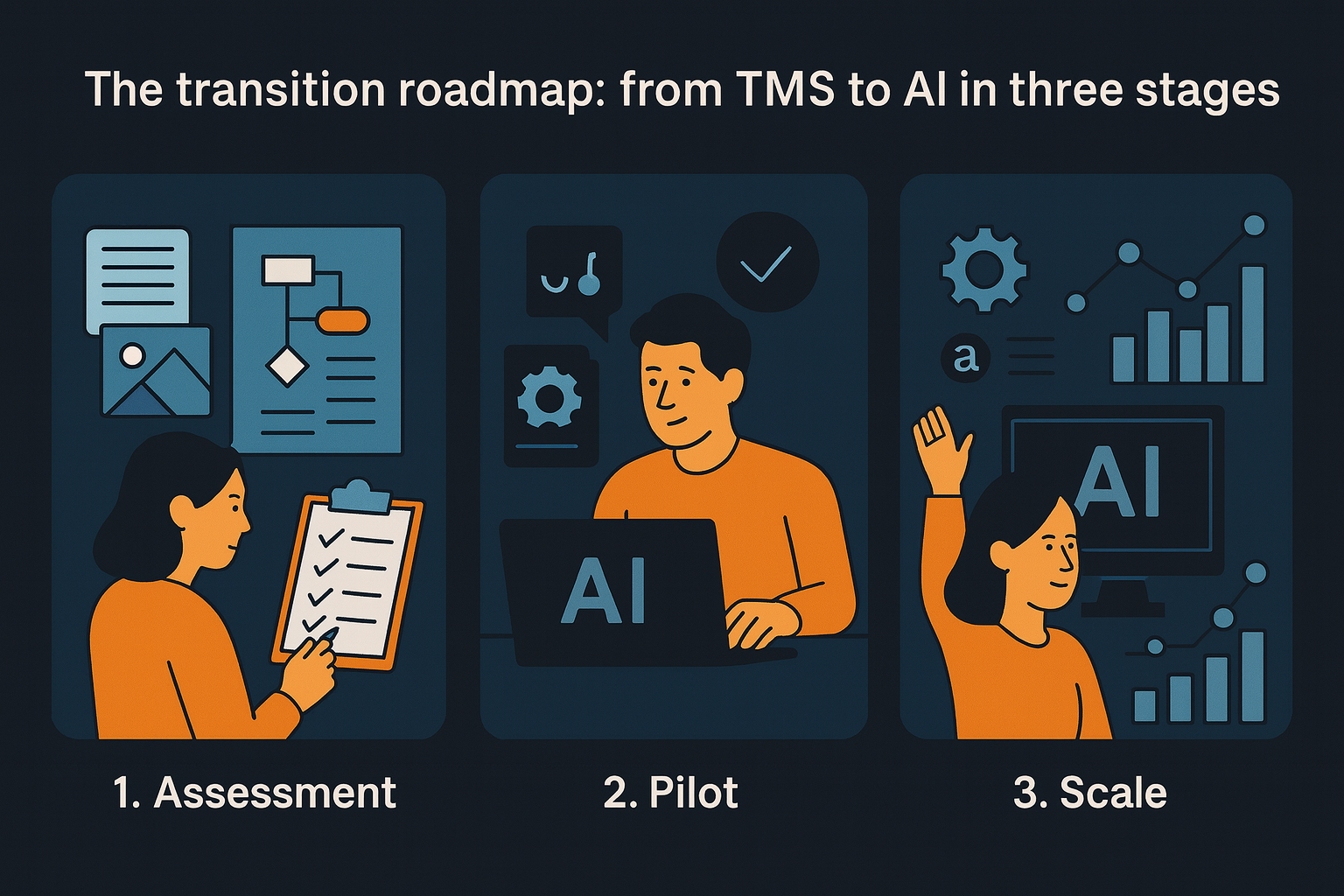
What’s the best way to transition my company from a Translation Management System to an AI solution for multilingual content?
Why now is the right moment to make the shift
If you’re responsible for delivering multilingual content at scale, you already know the limits of your Translation Management System (TMS): workflows are complex, human translation is slow and expensive, and scaling to new markets means scaling cost and headcount at the same time.

These platforms were designed for a slower, more predictable content cycle but today your business moves faster – product releases happen quarterly, campaigns are launched in weeks, and multilingual content requirements are growing exponentially.
Teams are under pressure to release products faster, localize marketing campaigns on tighter budgets, and keep brand voice consistent across dozens of markets. The reality? The existing workflow is holding you back – and your competitors are already experimenting with AI.
You’re not alone. Many companies currently using TMS including manufacturing firms, fashion brands and food producers are facing the same challenge. The competitive reality is simple – those who can adapt faster will lead.
This is why companies are moving to AI-powered multilingual content platforms. They promise speed, scalability, and cost control, while still allowing human oversight for quality-critical work.
For forward-thinking leaders the question isn’t if you’ll move to AI-powered multilingual content, but how you’ll make the transition without disrupting quality, compliance, or speed.
Here’s a suggested pathway for moving forward.
The transition roadmap: from TMS to AI in three stages
The smartest way to transition is not with a single “big bang” change, but with a deliberate, staged approach that builds confidence at every step.

1. Assessment – get clear on where you are
Begin by mapping your current localization process from end to end. Look at what you produce – from technical manuals to social media copy – and how it flows through the TMS.
Identify where delays occur, what your seasonal peaks look like, and what assets you already have. Existing translation memories, style guides, and industry-specific terminology lists are gold for an AI platform – they provide the foundation for faster, more accurate, more on-brand output.
Checklist
Start with a detailed audit of your current localization ecosystem:
- Content types: product manuals, marketing copy, compliance documents, multimedia
- Volumes and timelines: current throughput, seasonal peaks, bottlenecks
- Existing assets: translation memories, glossaries, style guides
- Integration points: CMS, DAM, ERP, collaboration tools
- Pain points: turnaround times, vendor costs, inconsistent quality, internal review bottlenecks
This baseline will help you identify where AI can deliver the biggest gains – whether that’s speed, cost reduction, or brand consistency.
2. Pilot – start small, prove value fast
Rather than replacing everything at once, choose a project where you can prove value quickly and measure clear ROI, such as:
- A manufacturing safety manual update across five languages
- A fashion brand’s seasonal lookbook campaign in three new markets
Once you’ve decided on your pilot project, define your KPIs in discussions with your wider team. What are you trying to accomplish? Be as specific as you can with this as “cost savings” is woefully vague. How much, in what ways and by when?
Next, make a note of some similar recent projects and their metrics:
- How many hours did it take to complete?
- How did the estimated project time compare to the actual time?
- Which part took the longest?
- What were the costs?
- Where were the sticking points?
- How many people were involved?
Use these to build a picture of your current situation. This info will serve as tangible benchmarks when exploring how, and to what degree AI solutions can help you with your multi-lingual content workflow.
Start a demo with purpose
Take advantage of the demo or trial period of these solutions to get an early indication of how your benchmarks may be improved.
Set aside some test content to be used as the source material for the trial. Ensure this content represents a reasonable scope of your needs. For consistency, use the same items as you trial each platform so you can compare the performance of each AI solution.
Once you’ve had a play and gotten a general idea, request an in-person demo to get an in-depth walkthrough and ask any further questions.
As well as your tangible benchmarks use this exploration period to note other factors that may influence the adoption of the platform in your business.
- How easy is the platform to use?
- What is the pricing model?
- Can it integrate into our existing tools?
- What training material and onboarding experience is available?
3. Scale – roll out with confidence
Once the pilot delivers measurable ROI, expand the AI workflow to other teams and content types. Automate repeatable steps using workflow orchestration, and reserve human involvement for high-stakes content such as legal disclaimers or compliance documents.
Track performance – turnaround times, cost savings, brand consistency – so you can demonstrate continuous improvement to stakeholders.

Key features multi-lingual AI solutions should have
When assessing AI translation solutions, ensure they include these vital features.
- Ability to leverage existing assets – feed translation memories, glossaries, and past projects into the AI to speed up output and ensure consistency.
- Use RLHF – over time, AI learns from your team’s edits, making future content more accurate and more on-brand.
- Secure integration – choose a platform that meets your data privacy requirements.
- Slots into current productivity tools – transitioning is less of a headache if AI tools work inside your current workflows.
What this looks like in practice
Manufacturing / Compliance – Straker partnered with IBM to address the challenge of auditing compliance-heavy documents at scale. By applying AI models within a secure, closed-loop environment, the joint solution reduced auditing time for large document collections to one-sixth of previous levels. For enterprises in manufacturing or regulated industries, this demonstrates how AI can transform multilingual compliance workflows while maintaining data security and control.

Fashion – The luxury retail sector is rapidly adopting AI for brand consistency and speed-to-market. Industry leaders like Prada are exploring AI for personalized experiences and streamlined content workflows – foundations that can extend naturally to multilingual content production. Platforms like Straker Verify ensure that, whether it’s a seasonal campaign or an e-commerce refresh, translations adhere to brand tone while hitting tight launch windows.
Why Verify stands apart
Verify combines AI speed with human-level quality control. It provides a quality score of every translation before you decide whether to involve a reviewer.
Your existing data – translation memories, industry terms, and style guides – aren’t left on the shelf; they’re fully embedded into the AI’s process, tuning the output to sound exactly like your brand.
You also get a secure, closed-loop system hosted by Straker, integration with tools you already use, and a flexible subscription model that scales with your needs. In short, you keep control while moving at the pace modern markets demand.
Verify delivers:
- AI + human quality assurance – speed without losing control
- RLHF-driven improvement – better results with every project
- Asset integration – translation memory, glossaries, and style guides baked in
- Automation – visual workflows, no code required
- Enterprise security – closed-loop hosting, no data leakage
- Flexible scaling – subscription plus token-based pricing
Take the first step
The shift from TMS to AI isn’t just a technology change – it’s a strategic move that can define your market position for the next decade. Start small, prove the ROI, and scale fast.
Your competitors are already reducing their translation costs by 50% or more and launching in weeks, not months. With the right AI solution, so can you.




.avif)
.avif)





